 I thought pillowy soft cookies made with coquito in the batter to celebrate National Coquito Day just made sense. What’s that? Didn’t you know it was National Coquito Day? Why, yes, Friend! December 21st is National Coquito Day. I thought everyone knew about this completely made-up holiday!! I’m going to pretend I knew about it all along. Surely we can support whoever creates these fake holidays by making a new cookie.
I thought pillowy soft cookies made with coquito in the batter to celebrate National Coquito Day just made sense. What’s that? Didn’t you know it was National Coquito Day? Why, yes, Friend! December 21st is National Coquito Day. I thought everyone knew about this completely made-up holiday!! I’m going to pretend I knew about it all along. Surely we can support whoever creates these fake holidays by making a new cookie.
I’m pretty sure it’ll be the softest cookie you’ve ever bitten into, too. Since I’m always down for indulging in a bit of coquito- it is one of my favorite parts of the holidays, after all- I thought that baking it into my cookies makes the most sense. But what made even more sense was topping it with a coquito-infused buttercream. Yep. I know how to celebrate fake holidays in grandiose style.
Come along.
What is coquito?
If you’ve not heard of Coquito, you are definitely new here. And that’s okay. Welcome. Spend more than a day with me, and you’re going to know what coquito is, where it’s from, and how you can repurpose it into other recipes. I’m not joking, either. Coquito is eggnog’s cuter, more popular Puerto Rican cousin. It is the most sought after drink during the holiday season. People usually start curing their batches right after Halloween. Some even sell theirs. I’m not trying to catch a case, so I just make mine for us and some to gift to friends.
Coquito is made with regular and sweetened coconut milk (fresh or canned), rum, and a generously spiced tea. Some folks like to use 151 to spike their coquito. I have chilled out in my old age and just use a mixture of three types of rum instead. The biggest debate about coquito is when it comes to whether or not eggs are added. I believe that if you offer me a cocktail, I would never dare to insult you by saying it’s not right. Add egg yolks if you want. Leave them out if you wish. You do you, Boo Boo. Just make sure my glass is always kept full.
What are Coquito Cookies?
Coquito cookies are the love child of a cup of coquito and a soft butter cookie. Instead of relegating myself to only sipping this cocktail, I wanted to bite into it. These cookies are a nod to the galletas de coco (or coconut cookies) that Hector used to love eating as a child back in his native Puerto Rico. I added the libation to the batter and the buttercream frosting that’s smeared on top of them. Each cookie gets a generous sprinkle of toasted coconut after frosting to triple down on the coconutty flavor.
If you’re not a huge fan of icing, these cookies, when naked, are still delightfully delicious. Because they’re so soft, you really don’t need any other topping for them. But, for me, the buttercream is the literal icing on top.
So, let’s get to it.
What do I need to make these Coquito Cookies?
Because these are coquito cookies, now is an excellent time to see if you have a bottle lying around. In addition to coquito, you need unsalted butter, light brown sugar, salt, all-purpose flour, baking powder, baking soda, ground cinnamon, an egg, vanilla extract, and gold rum. If you don’t have gold rum, feel free to use rum extract.
Have your ingredients at the same temperature before you begin mixing the cookie dough. You end up with a more cohesive dough that way.
Later, I’ll go over what you need for the coquito buttercream.
Can I use alcohol-free coquito for these cookies?
Since I know your kiddos will bumrush you over these cookies, I recommend using a virgin coquito. The alcohol in the cookie dough will bake off, but because we’re stirring the coquito into the buttercream, you may want to avoid using the spiked drink. Again, rum extract is an excellent substitute for the dark rum in the dough, but even regular rum will bake off.
How do I make the dough for Coquito Cookies?
Now for the moment you’ve been waiting for!
First, blend together the dry ingredients (minus the salt) in a mixing bowl using an electric hand mixer. This step just aerates the flour and combines the leaveners and cinnamon evenly with the flour.
Set this bowl aside.
Next, with your mixer on low speed, blend together the butter, brown sugar, and salt until smooth. Scrape down both the bowl and the beaters.
Once your butter is smooth, add the egg, vanilla, and rum (or rum extract) to the bowl. Blend, once more, on low speed until the egg is fully incorporated into the butter.
To build a well-balanced coquito cookie dough, add the flour mixture in two parts. First, add half of the dry mixture to the bowl and blend on low speed to mix it into the butter.
Scrape down the bowl and the beaters.
Second, add all of the coquito. Blend on low for 30 seconds. The dough will look grainy, but that’s because the liquid has caused an imbalance in the dough.
Add the last of the flour, and it’ll sort itself right out. Blend on low speed for one minute.
How long do I have to chill the cookie dough?
At this point, the dough will look like a very thick frosting. When you smooth it with a rubber spatula, it should hold its shape.
Cover the bowl with plastic wrap and chill it in the fridge for 45 minutes to 1 hour. Because the butter was warmed during mixing, the dough (if baked now) will run, and the cookies will bake up flat. Instead, chilling it for a few minutes allows not only the butter to firm back up but hydrates the flour as well. That hydrating of the flour gives the cookies a much better flavor after baking. It also allows the cookies to bake up nice and fluffy.
Can I freeze the cookie dough?
After mixing, you can also transfer the coquito cookie dough to a freezer storage bag or a container and freeze it. Instead of throwing the whole lump of dough in the freezer, though, I scoop it into balls as if I were going to bake them straight away.
Once the balls of dough are frozen solid, I transfer them to a freezer storage bag and freeze them, like so, for up to six months. I prefer this method for freezing cookie dough because I can bake the cookies off in smaller batches whenever I’m craving them. When you want to bake them, just bake them straight from the freezer- adding 2 additional minutes to their baking time to compensate for their being frozen.
How big should I scoop my Coquito Cookies?
No matter if you bake them straight away or freeze them after you chill the coquito cookie dough, use a number 30 portion scoop to scoop the cookies into balls. The scoop measures cookie dough balls that are about 4 ounces. This gives you uniform cookies to enjoy. If you don’t have a portion scoop, use a rounded tablespoon when scooping out your dough. Just try to keep them all the same size, so they bake at the same rate. Deposit the balls of cookie dough onto a silicone baking mat- lined sheet pan.
Slide the pan into a preheated, 350°F oven and bake the cookies for 15 minutes. I like my cookies to develop a deep brown color and 15 minutes is perfect. If you prefer a light brown cookie, bake them for 12-13 minutes instead.
What do I need to make the coquito buttercream?
While the cookies are baking, prepare the Coquito Buttercream.
To make it, you need unsalted butter (at room temperature), powdered sugar, salt, vanilla extract, and room temperature coquito. Again, if you are planning to serve underage revelers, be sure to use virgin coquito. You can also omit the coquito and add a teaspoon of rum extract with the vanilla. I’ll tell you how to thin the buttercream in a sec.
At low speed, blend together the butter, powdered sugar, and salt in a mixing bowl. Because there’s more sugar than butter, your end result may resemble white sand. That’s the way it should look. Pour the coquito and vanilla into the sugar and blend again at low speed. Stop the mixer and scrape down the bowl and beaters. Continue mixing on low until the buttercream is fluffy and evenly mixed.
If you omitted the coquito, thin the buttercream with whole milk. Just add a tablespoon at a time until it reaches a thick but spreadable consistency.
Can I make the buttercream ahead?
Once the coquito buttercream is mixed, covered it with plastic wrap, and set it aside or in the fridge until you’re ready to frost your cookies.
You can also make this buttercream up to a week ahead. Just store it in the refrigerator in a covered container. Twenty minutes before using, you need to remove it from the fridge and allow it the chance to warm up and soften a bit. You may even need to remix it for a minute or so to fluff it up.
You can freeze the buttercream as well. Simply transfer it to a freezer-safe container and freeze for up to 3 months—thaw the buttercream under refrigeration and use as needed.
This buttercream recipe makes enough to frost 3 dozen cookies, the same amount of cookies you will get from this cookie dough recipe. If you want to use this buttercream for cakes, double or triple the recipe.
How do I decorate my Coquito Cookies?
Remove your pan of cookies from the oven and allow them to cool on the sheet pan for a minute or two. Use a spatula to transfer the cookies to a cooling rack, then allow them to cool completely.
Continue scooping and baking the cookies like so until you have all of the cookie dough baked. If you have more than one sheet pan, you can scoop all of the cookie dough and refrigerate the balls of dough while the previous pans are in the oven.
To decorate your cookies:
- Scoop a generous amount (about 1 1/2 tablespoons) of the coquito buttercream onto the center of each cookie.
- Use an offset spatula or the back of a spoon to spread the buttercream into a circle.
- Just top with some lightly toasted coconut flakes and/or a sprinkle of ground cinnamon. You can also top yours with sprinkles that fit the theme of your celebration.
Can I freeze the cookies after frosting them?
Yes, you can freeze these coquito cookies after frosting them. I would do the same thing as freezing the ball of dough, though. Lay them in a single layer on a silicone- or parchment paper-lined sheet pan and freeze until solid. Once frozen, transfer them to a freezer-safe container or bag and freeze for up to two months. I prefer to do this because it reduces the likelihood of my frosting looking like crap afterward.
To thaw the cookies, just remove however many you want to eat and let them thaw at room temperature. Munch away once they’re thawed.
How do I serve the Coquito Cookies?
I eat these cookies in bed on a napkin, so I may not be the one to ask about fancy serving suggestions. Seriously.
You don’t need a whole elaborate set-up to serve them. Once your family and friends find out what they are, they’re not going to care about your fancy trays or plates. Shoot! Serve them straight from the cooling rack!
I do like to enjoy mine with a cup of café con leche or warm tea, though. The kiddos eat theirs with a glass of alcohol-free coquito because I raised them to be champions. If you’re expecting the Big Guy this Christmas, milk accompanies these cookies perfectly. Put in a good word for me, too. I may have made his naughty list this year.
How long are the Coquito Cookies good for?
It depends on whether or not you frosted all of them. If you did, you need to eat the cookies within 2 days. The sugar in the frosting will keep the cookies safe at room temperature for that long. Any longer, and you risk the butter and dairy in the buttercream going rancid. So, if you don’t think you’ll eat them all within a couple of days, leave the cookies unfrosted.
Naked cookies are safe at room temperature for 5 days. You can frost them “to order,” which, I think, is a much better idea.
How do I store leftover Coquito Cookies?
Store the cookies in an air-tight container to keep them from going stale quickly. I prefer to keep my cookies on the countertop because I hate the thought of biting into cold frosting and cookies. Plus, they get hard in the fridge.
You can store the frosted cookies in the fridge for a week, but the cold air will cause them to taste stale faster than if they’re kept at room temperature.
Want more ways to celebrate National Coquito Day?
I got you. You have to try these other recipes:
- Coquito Tres Leches
- or this Coquito Cream Pie
- my Coquito Cheesecake is always a hit
Okay! Get off the computer so you can make these before this auspicious “National Coquito Day” is over. And, if you just so happen to miss it, no worries. Unlike fake food holidays, these Coquito Cookies with Coquito Buttercream Frosting are a year-round event. Make it whenever you have a hankering for something coconutty.
Be sure to pin this recipe to your cookie boards and share it with your friends.

Coquito Cookies with Coquito Buttercream Frosting
at Sense & EdibilityEquipment
- electric hand mixer (or a stand mixer)
- a #30 portion scoop (optional)
Ingredients
For the Coquito Cookie Dough
- 3 1/2 cups (438 grams) all-purpose flour
- 2 teaspoons (5 grams) ground cinnamon
- 1 1/2 teaspoons (7 grams) baking powder
- 1 teaspoon (7 grams) baking soda
- 1 cup (226 grams) unsalted butter at room temperature
- 1 1/2 cups, packed (285 grams) light brown sugar
- 1/2 teaspoon (3 grams) kosher salt
- 1 large egg at room temperature
- 1 tablespoon gold rum or rum extract
- 1 teaspoon vanilla extract
- 1 cup (250 milliliters) coquito at room temperature
For the Coquito Buttercream Frosting
- 2 1/2 cups (335 grams) powdered sugar
- 1/2 cup (113 grams) unsalted butter at room temperature
- 1/4 cup (59 milliliters) coquito at room temperature (or substitute milk)
- 1 teaspoon vanilla extract (replace with rum extract if you're not using coquito in the frosting)
Optional Toppings
- toasted coconut flakes
- ground cinnamon
Instructions
Make the Coquito Cookie Dough
- In a mixing bowl and using an electric hand mixer, blend together the all-purpose flour, ground cinnamon, baking powder, and baking soda. Set this bowl aside.
- With your mixer on low speed, blend together the butter, brown sugar, and salt until smooth. Scrape down both the bowl and the beaters.Once the butter is smooth, add the egg, vanilla, and rum (or rum extract) to the bowl. Blend, once more, on low speed until the egg is fully incorporated into the butter.
- Add half of the dry (flour) mixture to the bowl, and blend on low speed to mix it into the butter.Scrape down the bowl and the beaters.
- Next, add all of the coquito to the batter. Blend on low for 30 seconds. The dough may look grainy at this point. Add the last of the flour and blend on low speed for one minute. The dough should look like a very thick frosting.
Chill the Dough, then Bake the Cookies
- Cover the bowl with plastic wrap and chill it in the fridge for 45 minutes to 1 hour.
- After chilling and 15 minutes before you plan to start baking, preheat your oven to 350°F (177°C). Line two or three sheet pans with silicone baking mats or parchment paper.
- Use a number 30 portion scoop, or a rounded tablespoon, to scoop the cookies into balls. Deposit 12 of these balls of cookie dough onto the prepared sheet pan.Continue scooping the cookies until you have scooped all of the dough.If you have more than one sheet pan, you can scoop all of the cookie dough and refrigerate the balls of dough while you begin baking the first pan of cookies.
- Bake the cookies for 15 minutes. Remove the pan of cookies from the oven and allow them to cool on the sheet pan for 1-2 minutes. Use a spatula to transfer the cookies to a cooling rack, then allow them to cool completely.
Prepare the Coquito Buttercream
- With your mixer on low speed, blend together the powdered sugar, butter, and salt in a mixing bowl. Because there's more sugar than butter, the mixture may resemble white sand. That's the way it should look.
- Pour the coquito and vanilla into the sugar and blend again at low speed. Stop the mixer and scrape down the bowl and beaters. Continue mixing on low until the buttercream is fluffy and evenly mixed.
- If you omitted the coquito, thin the buttercream with whole milk, instead. Just add a tablespoon at a time until it reaches a thick but spreadable consistency.Once the coquito buttercream is mixed, covered it with plastic wrap, and set it aside or in the fridge until you're ready to frost your cookies.
Decorate the Coquito Cookies
- Scoop a generous amount (about 1 1/2 tablespoons) of the coquito buttercream onto the center of each cookie.
- Use an offset spatula or the back of a spoon to spread the buttercream into a circle.
- Sprinkle a generous pinch of lightly toasted coconut flakes and/or a sprinkle of ground cinnamon over the coquito frosting. Serve them with coquito, milk, tea, or coffee.
Notes
To Freeze Pre-Baked Coquito Cookie Dough:
- Scoop the coquito cookie dough into balls and onto a lined sheet pan as if you were going to bake them straight away. Place the sheet pan into the freezer.
- Once the balls of dough are frozen solid, transfer them to a freezer storage bag and freeze them for up to six months.
- Bake the cookies straight from the freezer- adding 2 additional minutes to their baking time to compensate for their being frozen.
To Make the Coquito Buttercream (up to 1 week) Ahead:
- Store the mixed buttercream in the refrigerator in a covered container.
- Twenty minutes before using, remove it from the fridge and allow it to warm up to soften a bit.
- Remix the buttercream as needed with a mixer on low speed.
To Freeze the Coquito Buttercream:
- Transfer the buttercream to a freezer-safe container.
- Freeze it for up to 3 months.
- Thaw the buttercream under refrigeration and use as needed.
- This buttercream recipe makes enough to frost 3 dozen cookies. If you want to use this buttercream for cakes, double or triple the recipe.
To Freeze Frosted Cookies:
- Lay the cookies in a single layer on a silicone- or parchment paper-lined sheet pan.
-
Freeze the cookies until solid.
Once frozen, transfer them to a freezer-safe container or bag and freeze for up to two months. - To thaw the cookies, just remove however many you want to eat and let them thaw at room temperature.
To Store Frosted Coquito Cookies:
- Eat the cookies within 2 days if you're storing them at room temperature.
- Eat the cookies within 1 week if you're storing them in the refrigerator. Note: the cold air will cause them to taste stale faster than if they're kept at room temperature.
To Stored Unfrosted Coquito Cookies:
- Store the cookies in an air-tight container for up to 5 days. Store the Coquito Buttercream in the refrigerator in a covered container.
- Frost the cookies as needed.






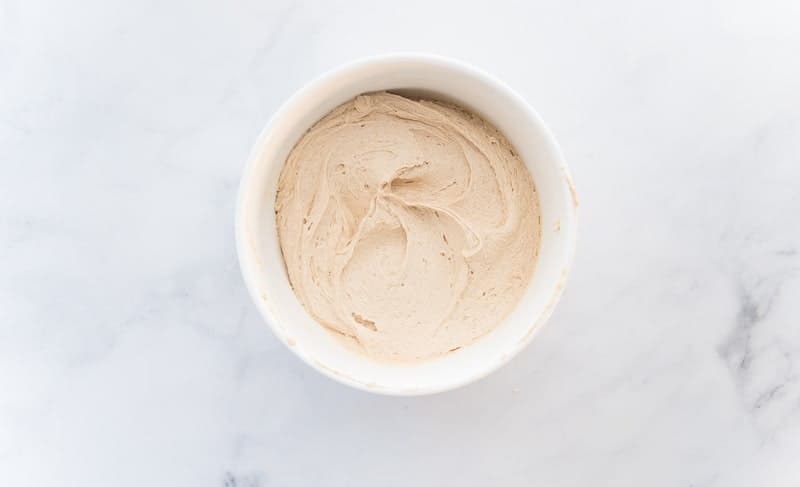

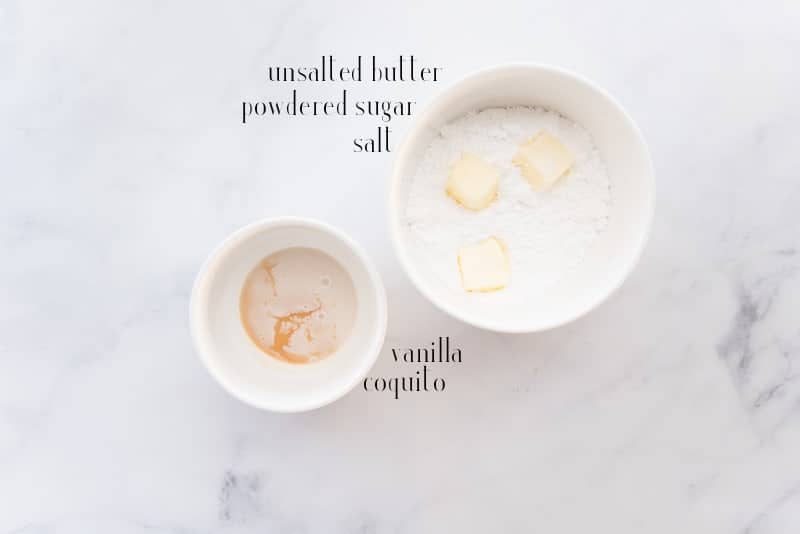


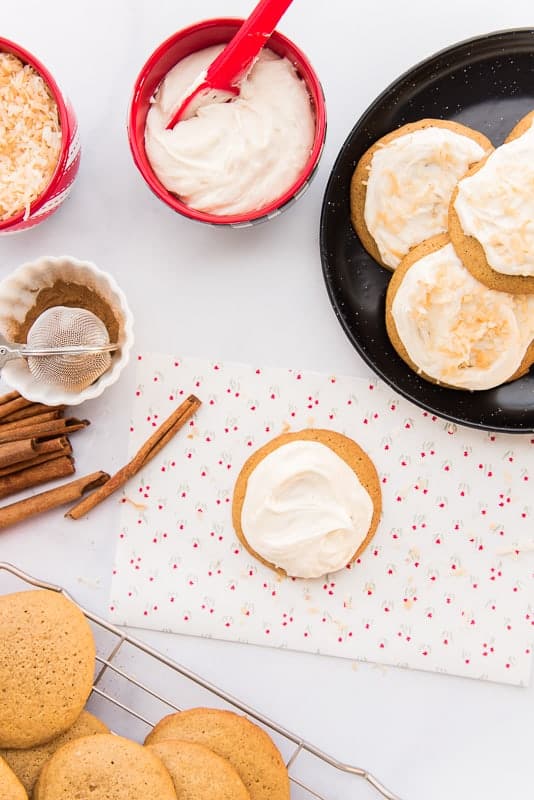
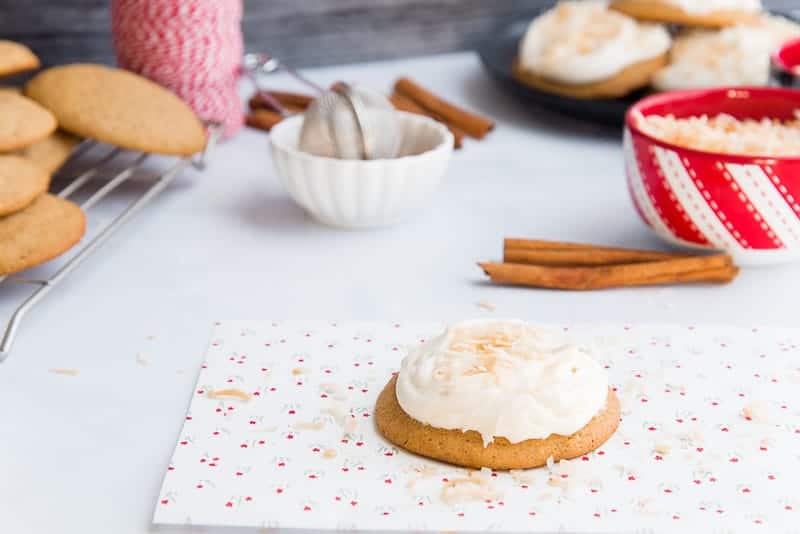
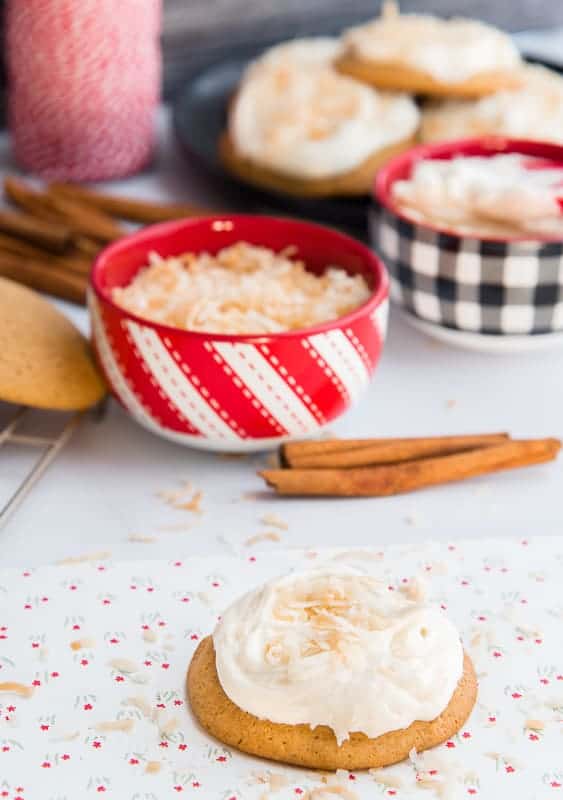






I wish I could explain why I love these so much. The flavors aren’t my typical “go to” treats but I had ONE of these and they instantly jumped to the top of my favorites list.
They are also great for sharing as a “welcome to the neighborhood” or “thanks for everything” gift. They have a way of satisfying even the pickiest sweet tooth!
They truly are satisfying, Angie. Thanks!